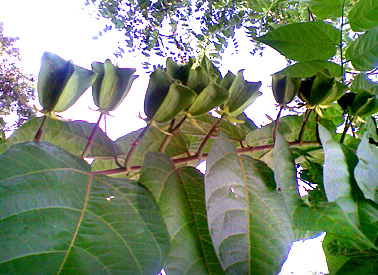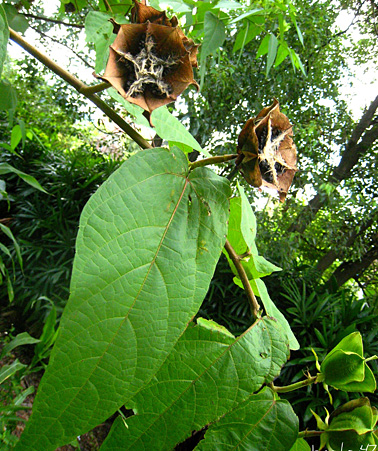|
Botanical Name:
Abroma augusta
Ulatkambal consists of dried roots of Abroma augusta Linn f.
(Synonym Abroma fastuosa), Family Sterculiaceae
Common Name(s) in English & Indian Languages
Sanskrit: Pisacha karpus, Pivari, Ritumati, Ucchat,
Yonipushpa
Assamese: Bon kopashi
Bengali: Ulat kambal
English: Devill's cotton, Indian hemp
Guajarati: Ulat kambal, Olakatbol
Hindi: Ulat kambal
Marathi: Ulat kambal, Olakatambol
Tamil: Sivapputtutti
Telugu: Gogu, Kondagogu
Urdu: Ulat kambal
Botanical description:
Abroma augusta Linn f. is a shrubs and small tree, attaining
a height of 3-5 meters with horizontal and velvety branches.
The branches and branch lets are downy. The leaves are
alternate. The dry roots have 0.5-1.0 mm thick, highly
fibrous, brown barks; the thickness of the bark varies
according to the age and girth of the root. The outer
surface of the bark is dull brown and longitudinally
wrinkled with small warty markings; the outer surface is
whitish yellow and finely longitudinally striate. Leaves are
polymorphous about 10-30 cm. long and 6-18 cm. broad, repand-denticulate,
base 3-7 lobed, cordate nerved, upper non-lobed, ovate-lanceolate;
smaller, narrower, entire, glabrescent above, tomentose
below; petiole 12-25 mm. stipules linear, deciduous, as long
as the petiole. Flowers are 5 cm. in diameter, dark red,
purple or yellow in colour occurring on few flowered cymes.
Sepals are 2.5 cm. lanceolate, free nearly to the base.
Petals scarcely exceeding the sepals, imbricate in bud,
deciduous. And fall soon. Stemens are present on short
staminal tube. Five staminoides are present. Seeds many,
small, blackish, covered with silky hairs.
Parts used:
Dried roots
Major chemical constituent
Alkaloids
Therapeutic uses:
• Dysmenorrhoea (Asrgdara Ruja)
• Ammenorrhoea (Nashtartava)
• Menstrual disorder (Rajodosa)
• Uterine disorders (Garbhasya dosa)
• Diabetes (Madhumeha) |
|


|
|
|



